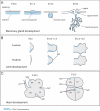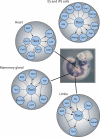Diverse functional networks of Tbx3 in development and disease
- PMID: 22334480
- PMCID: PMC3328642
- DOI: 10.1002/wsbm.1162
Diverse functional networks of Tbx3 in development and disease
Abstract
The T-box transcription factor Tbx3 plays multiple roles in normal development and disease. In order to function in different tissues and on different target genes, Tbx3 binds transcription factors or other cofactors specific to temporal or spatial locations. Examining the development of the mammary gland, limbs, and heart as well as the biology of stem cells and cancer provides insights into the diverse and common functions that Tbx3 can perform. By either repressing or activating transcription of target genes in a context-dependent manner, Tbx3 is able to modulate differentiation of immature progenitor cells, control the rate of cell proliferation, and mediate cellular signaling pathways. Because the direct regulators of these cellular processes are highly context-dependent, it is essential that Tbx3 has the flexibility to regulate transcription of a large group of targets, but only become a active on a small cohort of them at any given time or place. Moreover, Tbx3 must be responsive to the variety of different upstream factors that are present in different tissues. Only by understanding the network of genes, proteins, and molecules with which Tbx3 interacts can we hope to understand the role that Tbx3 plays in normal development and how its aberrant expression can lead to disease. Because of its myriad functions in disparate developmental and disease contexts, Tbx3 is an ideal candidate for a systems-based approach to genetic function and interaction.
Copyright © 2012 Wiley Periodicals, Inc.
Figures



Similar articles
-
Mouse TBX3 mutants suggest novel molecular mechanisms for Ulnar-mammary syndrome.PLoS One. 2013 Jul 2;8(7):e67841. doi: 10.1371/journal.pone.0067841. Print 2013. PLoS One. 2013. PMID: 23844108 Free PMC article.
-
The ulnar-mammary syndrome gene, Tbx3, is a direct target of the retinoic acid signaling pathway, which regulates its expression during mouse limb development.Mol Biol Cell. 2012 Jun;23(12):2362-72. doi: 10.1091/mbc.E11-09-0790. Epub 2012 Apr 25. Mol Biol Cell. 2012. PMID: 22535523 Free PMC article.
-
TBX3 regulates splicing in vivo: a novel molecular mechanism for Ulnar-mammary syndrome.PLoS Genet. 2014 Mar 27;10(3):e1004247. doi: 10.1371/journal.pgen.1004247. eCollection 2014 Mar. PLoS Genet. 2014. PMID: 24675841 Free PMC article.
-
The T-box transcription factors TBX2 and TBX3 in mammary gland development and breast cancer.J Mammary Gland Biol Neoplasia. 2013 Jun;18(2):143-7. doi: 10.1007/s10911-013-9282-8. Epub 2013 Apr 28. J Mammary Gland Biol Neoplasia. 2013. PMID: 23624936 Free PMC article. Review.
-
The special stemness functions of Tbx3 in stem cells and cancer development.Semin Cancer Biol. 2019 Aug;57:105-110. doi: 10.1016/j.semcancer.2018.09.010. Epub 2018 Sep 27. Semin Cancer Biol. 2019. PMID: 30268432 Review.
Cited by
-
Overexpression of Tbx3 is correlated with Epithelial-Mesenchymal Transition phenotype and predicts poor prognosis of colorectal cancer.Am J Cancer Res. 2014 Dec 15;5(1):344-53. eCollection 2015. Am J Cancer Res. 2014. PMID: 25628943 Free PMC article.
-
Hierarchical deployment of Tbx3 dictates the identity of hypothalamic KNDy neurons to control puberty onset.Sci Adv. 2022 Nov 18;8(46):eabq2987. doi: 10.1126/sciadv.abq2987. Epub 2022 Nov 16. Sci Adv. 2022. PMID: 36383654 Free PMC article.
-
Differential analysis of gene regulation at transcript resolution with RNA-seq.Nat Biotechnol. 2013 Jan;31(1):46-53. doi: 10.1038/nbt.2450. Epub 2012 Dec 9. Nat Biotechnol. 2013. PMID: 23222703 Free PMC article.
-
TBX3 is dynamically expressed in pancreatic organogenesis and fine-tunes regeneration.BMC Biol. 2023 Mar 20;21(1):55. doi: 10.1186/s12915-023-01553-x. BMC Biol. 2023. PMID: 36941669 Free PMC article.
-
Transcriptional repressor Tbx3 is required for the hormone-sensing cell lineage in mammary epithelium.PLoS One. 2014 Oct 24;9(10):e110191. doi: 10.1371/journal.pone.0110191. eCollection 2014. PLoS One. 2014. PMID: 25343378 Free PMC article.
References
-
- Herrmann BG, Labeit S, Poustka A, King TR, Lehrach H. Cloning of the T gene required in mesoderm formation in the mouse. Nature. 1990;343(6259):617–622. - PubMed
-
- Tada M, Smith JC. T-targets: clues to understanding the functions of T-box proteins. Dev Growth Differ. 2001;43(1):1–11. - PubMed
-
- Papaioannou VE, Silver LM. The T-box gene family. Bioessays. 1998;20(1):9–19. - PubMed
-
- Chapman DL, Garvey N, Hancock S, Alexiou M, Agulnik SI, et al. Expression of the T-box family genes, Tbx1-Tbx5, during early mouse development. Dev Dyn. 1996;206(4):379–390. - PubMed
MeSH terms
Substances
Supplementary concepts
Grants and funding
LinkOut - more resources
Full Text Sources

